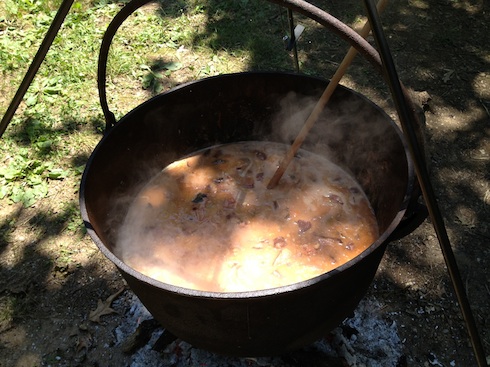Making 50 servings
This is a stand-alone recipe. For lesser quantities, see the simple family-sized version
- 6 lb dried Great Northern beans
- 2 ducks or 1 goose, halved
- a 10-12 lb whole leg of lamb cut into 2" thick slabs
- 2-4 smoked ham hocks (see notes)
- a smoked ham of about 15 lbs, quartered
- about 10 lbs garlicky smoked sausage like Polish kielbasy (see notes), cut diagonally into 1" lengths
- 3 lb meaty bacon ends, roughly chopped
- 2 lb onions, roughly chopped
- 2 lb carrots, roughly chopped
- 1 entire bulb of garlic, peeled and chopped
- pepper, thyme, bay
- 20 oz tomato paste
- 1 lb celery, roughly chopped
- a large handful of fresh parsley, chopped
- dried thyme
Special equipment
- Oh, just a 25 to 40 gallon cauldron and enough firewood to keep it boiling for half a day
- Oh, yeah, and a 3 foot long wooden spoon
- Don’t forget the extra long ladle
- And a barbeque grill for browning the lamb and poultry (see notes)
Special Instructions for quantity cookery
- The methodology here is very different from indoor family-sized cookery because you have a single, intense heat source and therefore little flexibility. For example, were you to try to fry your bacon in the cauldron as the first step, you’d end up incinerating your first ingredient. Not a good start. There will be some separate browning of a few special ingredients, but most will just get tossed in the boil.
Soak the beans overnight in about 2 quarts of water for each pound of beans. Rinse the next morning before assembly.
Brown the birds skin-side-down on your grill. Yes, they’re fatty; yes they’ll char; that’s what you’re going for. You don’t want to cook them through, you just want to brown one side. Divide each half into quarters and reserve.
Brown the lamb the same way. Then cut into large chunks and reserve.
Now raise your kettle. Bring about 4-5 gallons of water to a boil (you’ll want enough water to cover the ingredients but not so much that you make a soup instead of a stew. If you have no lid, you’ll want 5 gallons, not 4). Be aware it may take an hour to heat that much water. Add beans, bird parts, lamb, hocks, ham, sausage, bacon, onions, carrots, herbs, garlic and bring back to a boil and simmer slowly for at least an hour and a half. Add tomato paste, celery, and parsley and simmer for another hour. You don’t have to worry about overcooking a cassoulet. It should cook long and slow.
Before serving, remove the hocks and trim the meat from the bones, cut into 1" pieces, and toss back in. Discard the bones. If your ham hasn’t come apart into bite size pieces from your stirring, hack it as well.
Ideally, you should reduce or eliminate the heat a half hour before serving because this stew takes a long while to cool down whether in the cauldron or in individual serving-sized bowls.
Notes
- The kielbasy is the key ingredient here. You need a garlicky sausage, and it’s surprising how many American culinary writers (even her highness Julia Child) recommend Polish kielbasy (singular: kielbasa) for a French national dish. And they don’t mean that sterile plastic-wrapped industrial baloney in your supermarket. They mean real smoked kielbasy from a local ethnic butcher. No Eastern European butchers in your local farmers market? Then try the German one. No French, German, Polish, Hungarian or even Slovak butchers in your area? Time to expand your search area. We’re lucky to have a town one county over that has so many kielbasy makers, each with their own century-old recipes, that the town holds a famed annual kiebasy festival. Fresh, smoked, even super-dark double-smoked, each shop’s recipe is different, and every family has its own preferences. Whose is best? On that topic there is much debate. ↩
Should you have a French charcuterie nearby, then your possiblities are endless. Hmm, which sausage to choose? De campagne, de méage, á cuire, á l’ail, or de Morteau? Hey, how about saucisson? Did you want to make a Toulousain cassoulet? Maybe you prefer the style of Castelnaudary. No? Carcassonne? Ariege? Montalban, Quercy, or Perigord? Each region thinks theirs is best.
Hey, what about an Andouille sausage? That’s a French sausage readily available in the States. Alas, no; American, that is, Cajun, Andouille is spiced very much more strongly than its continental antecedent and is not suitable here.
Originally we marked the ham hocks as an optional ingredient. No longer. The collagen they add from slow cooking helps to thicken the stew and are now a required ingredient. You don’t have to use smoked ham hocks. Fresh will work just as well if not better, but smoked hocks are easier to find. See the discussion under
Schweinshaxe ↩.A good time to stock up on these ingredients is Easter weekend when there are unmatchable deals on both ham and lamb.
Daniel Butt’s Wishbone Forge makes a remarkable tripod that will support your kettle and also comes with an adjustable grill for browning those meats. Use the three hooks for the grill, but omit them completely for hanging the kettle.↩.
Suggestions
- While there is no added salt in the recipe, all that nitrated pork will dehydrate your patrons. Make sure you have plenty of cold beer on hand or at least one for the chef (thanks, Dory). Next time we’ll use pork butt instead of the ham to reduce the sodium.

